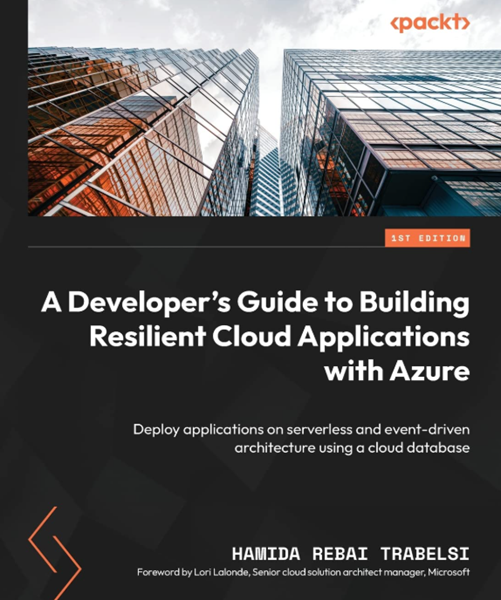Book Review: A Developer's Guide to Building Resilient Cloud Applications with Azure

Hamida Rebai Trabelsi started her professional career in Tunisia working for multinational corporations as a software developer, then served as a .NET consultant in Canada. She is currently a senior advisor and information and solution integration architect. She has been awarded as Most Valuable Professional (MVP) in Developer Technologies and as a Microsoft DevHero by Microsoft.
Thanks to the people at PackT, I recently had the pleasure of reviewing another one of her new books: A Developer’s Guide to Building Resilient Cloud Applications with Azure .
Content
Book starts by making the case for serverless architectures, event-driven architectures, and cloud databases.
In chapter 2, API management is discussed. I see so many badly designed APIs in the commercial marketplace. I wish there was more focus on this across the industry.
In chapter 3, event-based and message-based solutions are described. This is an area I’ve always loved seeing developed, yet in the data community (where I spend most of my time), I find that many people just don’t “get” it.
Chapter 4 describes function apps in Azure. I use these regularly and am a fan of them. It was good to see durable functions mentioned as well.
Chapter 5 heads into service fabric and distributed applications. I liked that it covers both local and remote deployment of these.
Chapter 6 headed into data i.e., my main territory and discussed relational vs non-relational concepts.
Azure SQL Database is the platform service that I use the most. It’s covered in chapter 7, as well as a discussion around Azure SQL MI. I’m not a fan of the MI offering, which I’m sure is a sad thing for several of my friends who work on that team. I’m down to only having a handful of customers who are using it, and mostly that’s because they have a large number of databases. MI works ok for that.
Chapter 8 gives a good introduction to Azure Storage, another service that I use daily. Table storage is also described, but it’s another one that I’m not really a fan of.
99% of the time, when you think table storage is the right answer, something like Cosmos DB is a better answer. So it’s great to see that was covered in chapter 9.
Near the end of the book, an intro to a variety of tools is provided: Azure Data Lake Storage (ADLS), Azure Data Factory (ADF), Azure Synapse Analytics (ASA), and Azure Analysis Services (AAS). I continue to be a big fan of ADLS, ADF, and AAS, even though Microsoft just wants us to use Fabric for all these things. It’s a real pity to see AAS, in particular, seem to have become “abandonware”, where a good product is just left to rot over time. No new features will appear for it, and any time you ask, it will be clear that Fabric is the only acceptable direction. Wish it wasn’t so.
In chapter 11, the book finishes out with a discussion on continuous integration/continuous delivery (CI/CD). The discussion is predominantly based around the use of containers, which I rarely use. I tend to deploy services using either ARM templates, or Bicep.
Summary
This is another good book from Hamida. It has a really good range of coverage, for many of the core technologies that we need.
8 out of 10
2025-04-18
